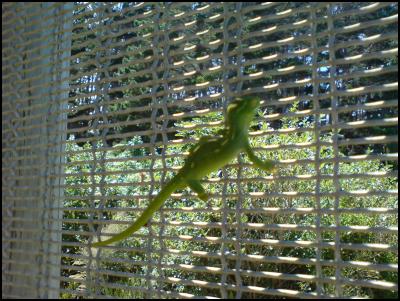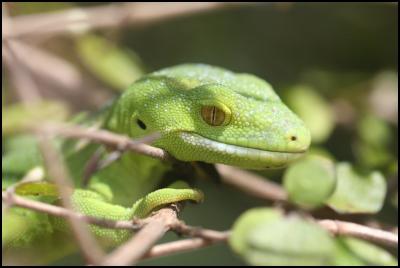Return of the native
Return of the native

Click to enlarge
Let me in! A mountain biker snapped this rare Wellington green gecko on the outside of the Karori Sanctuary fence. Green geckos haven’t been recorded in the area since the late 70s. Photo by Daniel Coe

Click to enlarge
Wellington Green Gecko by Tom Lynch
MEDIA RELEASE & PHOTO
24 January 2008
Return of the native
An elusive Wellingtonian has made a surprise re-appearance after an absence of nearly 30 years.
Once widespread throughout the Region, the Wellington green gecko has been in gradual decline for many years due to habitat loss and predation. Although reports from the capital are not unheard of, most sightings come from outside of the city. The last reliable sighting in Karori was nearly 30 years ago. Surveys by herpetologists since 2003 have recorded six lizard species in the Sanctuary but the green gecko was notably absent.
‘When I saw the photo of a green gecko on the Sanctuary fence, it really made my day’ said Sanctuary conservation scientist Raewyn Empson.
‘If they have survived outside the fence, then there is every chance there is still a population living inside the Sanctuary too. We have never ruled out the possibility, but searches to date have been unsuccessful. Now at least we know where to start looking.’
Despite their showy colouring, green geckos are notoriously hard to ’spot. To help visitors know what to look out for, Karori Sanctuary recently got funding from the New Zealand Community Trust to create a green gecko enclosure as part of their display on native lizards.
‘It’s great to give our visitors the opportunity to see these animals close up’ says Ms Empson
‘You’re doing well if you see all six – it really makes you appreciate how well-camouflaged they are. We hope that once visitors know what they’re looking for, people will start finding them out in the valley.’
All New Zealand lizards are legally protected, but under threat from habitat destruction and predators. The good news is it’s not hard to help them out by making your backyard more lizard-friendly. Here are a few pointers:
1. Make hiding places out of rock heaps, or make a lizard shelter.
2. Plant native grasses to attract delicious insects or dense native shrubs like Coprosma spp, whose berries lizards also like to eat.
3. Control mice and rats in your backyard by trapping them.
4. Cats are significant predators of lizards. Look at the Department of Conservation’s website for their responsible cat ownership recommendations.
5. Report all gecko sightings to the nearest DOC office.
6. Check out the new lizard display at Karori Sanctuary or contact your local DOC office for more ideas!
More information on native geckos:
o There are at least 39 species of gecko in New Zealand
o The Wellington green gecko (Naultinus elegans punctatus) is endemic to New Zealand
o It is found only in the southern half of the North Island
o It is larger and greener than the closely-related Auckland green gecko (Naultinus elegans elegans) which lives in the north of the North Island
o Geckos are the only lizards that are able to vocalise. New Zealand geckos produce a chirping sound.
o Geckos have ‘sticky’ feet: their toes are covered with microscopic hairs that allow them to climb sheer surfaces and even walk upside down across the ceiling. They are one of the few land animals that could make it over the Sanctuary’s fence!
o New Zealand geckos are unusual in that they give birth to live young rather than laying eggs; the only other geckos that do this live in New Caledonia.
ENDS


 Stats NZ: Business Employment Data - December 2024 Quarter
Stats NZ: Business Employment Data - December 2024 Quarter Transpower: System Operator Launches Review Of Electricity Risk Forecasting Framework
Transpower: System Operator Launches Review Of Electricity Risk Forecasting Framework  The Conversation: NZ’s Glaciers Have Already Lost Nearly A Third Of Their Ice – As More Vanishes, Landscapes And Lives Change
The Conversation: NZ’s Glaciers Have Already Lost Nearly A Third Of Their Ice – As More Vanishes, Landscapes And Lives Change RBNZ: Reserve Bank Of New Zealand Welcomes The Release Of Te Ōhanga Māori 2023 Report
RBNZ: Reserve Bank Of New Zealand Welcomes The Release Of Te Ōhanga Māori 2023 Report Bill Bennett: Download Weekly - One NZ chooses Ericsson for core network update
Bill Bennett: Download Weekly - One NZ chooses Ericsson for core network update Mountains to Sea Conservation Trust: Orange Roughy Leads The Pack As Fish Of The Year Heats Up
Mountains to Sea Conservation Trust: Orange Roughy Leads The Pack As Fish Of The Year Heats Up



